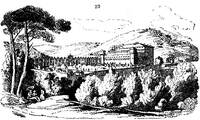110. The villas of Rome, Forsyth observes, are to this day the 'ocelli Itali�.' Their team generally stand to advantage in the park ; light, gay, airy, and fanciful. In the ancient villas the buildings were low, lax, diffused, and detached. In the modern, they are more compact, more commodious, and rise into several stories. In both, the gardens betray the same taste for the unnatural, the same symmetry of plan, architectural groves, devices cut in box, and tricks performed by the hydraulic organ. (Rem. on Italy, p. 173.) The gardens of the Quirinal Palace occupy a fine situation, overlooking great part of Rome; and art has adorned them with the Papal arms in coloured sand, slags, broken pots, and other beauties of that sort. (Wood's Letters, &c., vol. i. p. 452.) The Villa Borghese (fig 23.) is the most noted in the neighbourhood of Rome. It has a variety of surface formed by two hills and a dell, and a variety of embellishments, casinos, temples, grottoes, aviaries, modern ruins, sculptured fountains, a crowd of statues, a lake, an aqueduct, and a circus; but it wants the more beautiful variety of an English garden; for here you must walk in right lines, and turn at right angles, fatigued with the monotony of eternal ilex (Q. I'lex). (Remarks, &c., p. 216.) Eustace says these gardens are laid out with some regard both for the new and the old system, because winding walks are to be found intersecting the long alleys. This is true; but the whole is so frittered down by roads, walks, paths, and alleys, and so studded with statues and objects of art, as to want that repose, simplicity, and massive appearance, essential, at least, to an Englishman's idea of an English garden. Simplicity, however, is a beauty less relished among the nations of the Continent than in this country, and less relished by the Italians than by any other continental nation. The Villa Borghese, Wood observes, is a garden, or pleasure-ground, said to be three miles in circumference, with shady walks, which he found delightful as early as the 4th of February, and tall stone pines scattered about the more open parts. These trees, and the evergreen oaks, are the most important circumstances in the beauty of the place. There is a pretty lake, and a considerable variety of ground and of scenery; and several buildings, not perhaps very beautiful in themselves, but assisting the general character of the place. Art appears every where, but not obtrusively, and without pretence. (Letters of an Architect, Vol. ii. p. 28.) The Villa Panfili displays the most architectural gardens of any about Rome. Here, as Forsyth observes, hedges of laurels, porticoes of Quercus I'lex, green scutcheons, and clipped coronets, are seen vegetating over half an acre, with theatres of jets d'eau, geometrical terraces, built rocks, and measured cascades. The Villa d'Este. Tradition says that Ariosto lived here, with his friend Cardinal Ippolito, and wrote great part of his Orlando. (Graham's Three Months in the Mountains near Rome.) The construction of this villa, Wood observes, �is on a scale which may entitle it to be mentioned among these ancient productions. Terrace rises above terrace, and a copious supply of water rushes down an artificial rock 34 feet in height, spreading in a beautiful manner as it descends; while the whole is crowned by the long facade of the palace.� (Letters of an Architect, &c., vol. ii. p. 67.) Cadell found this villa, in 1818 (as we did in 1819), in a very neglected state. (Travels, &c., p. 457.)

